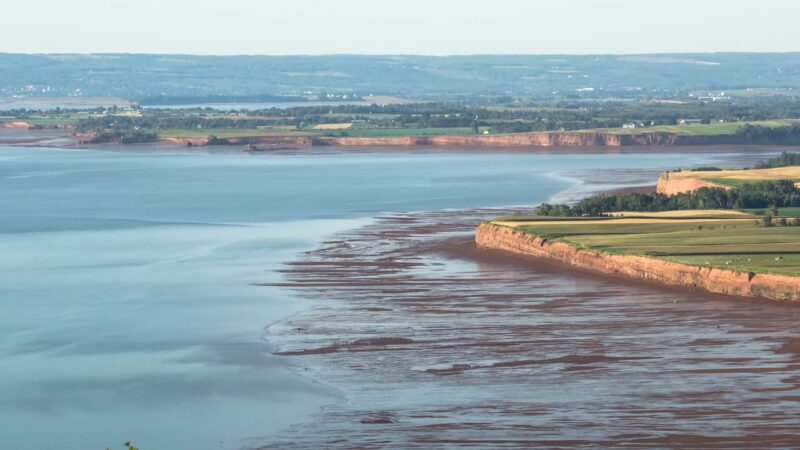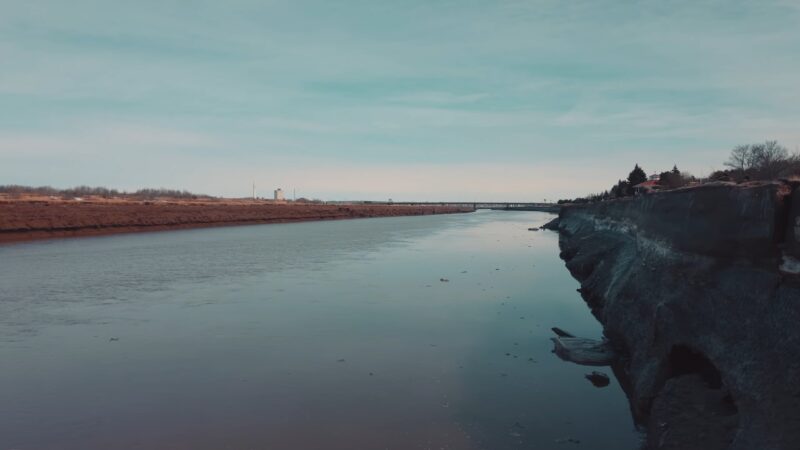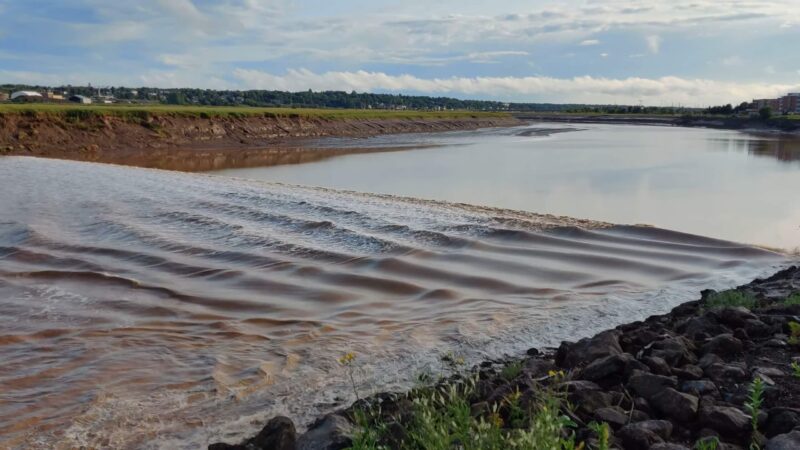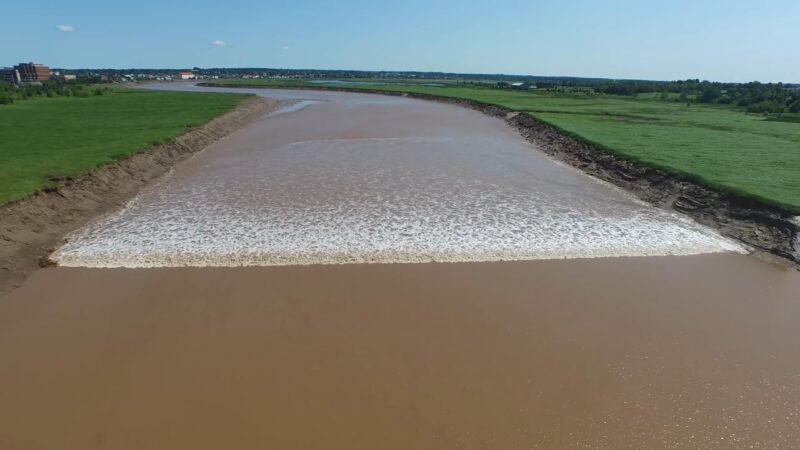The tidal bore in Moncton is a natural phenomenon, which is primarily caused by the unique interplay of the Bay of Fundy’s unparalleled tides and the geographical features of the Petitcodiac River.
This phenomenon is characterized by a wave that travels upstream against the current of the Petitcodiac River. It is not merely a local curiosity but a dynamic interplay of geographical, environmental, and human factors. Together, these elements create the perfect conditions for the tidal bore to occur.
Key Takeaways
- The Bay of Fundy’s exceptional tides, the highest in the world, are essential for Moncton’s tidal bore, with its vast tidal range facilitating this phenomenon.
- The Petitcodiac River’s specific geography, including its shape and estuary characteristics, enables the tidal bore’s formation by supporting the wave’s upstream movement. This occurrence is primarily due to the bay’s and river’s unique configuration.
- Environmental elements like wind and changes in river depth, alongside human interventions such as dredging and construction, significantly affect the tidal bore, underscoring the importance of both natural conditions and human actions in its manifestation and preservation.
The Bay of Fundy’s Tides

The Bay of Fundy, situated between the Canadian provinces of New Brunswick and Nova Scotia, is renowned for having the highest tides in the world.
The magnitude of these tides is a critical factor in the formation of the tidal bore. Twice a day, over 100 billion tonnes of water flow in and out of the bay, creating a significant difference in water levels between high and low tides.
This vast movement of water is the driving force behind the tidal bore. This Bay experiences one of the world’s most extreme tidal ranges.
The Petitcodiac River’s Geography

The Petitcodiac River plays a crucial role in the formation of the tidal bore. The river’s shape, depth, and the width of its estuary where it meets the Bay of Fundy are pivotal.
The Petitcodiac River extends approximately 79 kilometers (about 49 miles) from the Bay of Fundy into southeastern New Brunswick. Its shape plays a significant role in the formation of the tidal bore.
As the river progresses inland, it narrows, creating a funneling effect that amplifies the incoming tide from the Bay of Fundy. This funneling effect is crucial for the formation of the tidal bore, as it concentrates the tide’s energy, allowing a single wave to form and travel upstream.
The depth of the Petitcodiac River is another critical factor. Tidal bores typically form in relatively shallow rivers because the incoming tide can more easily overcome the river’s natural outflow.
The river’s bed, composed of mud and silt, is shaped by the constant ebb and flow of tides, contributing to the varying depth that is conducive to the bore’s formation.
The estuary of the Petitcodiac River, where it meets the Bay of Fundy, is notably wide and flat. This geographical feature is essential for the tidal bore’s occurrence.
The wide and flat estuary allows the massive volume of water from the Bay of Fundy’s high tide to accumulate and then forcefully push back into the river, creating the bore. The estuary acts as a buffer zone where the tidal forces gather strength before moving upstream.
The Mechanism of the Tidal Bore

A tidal bore occurs when the leading edge of the incoming tide forms a wave that travels upstream against the river’s current. In Moncton, the tidal bore is generated when the high tides from the Bay of Fundy begin to push into the Petitcodiac River.
The unique funnel shape and the resonance period of the bay amplify these tidal movements, resulting in some of the highest tides in the world. When the tide is at its peak, the volume of water attempting to enter the bay significantly exceeds the space available in the river’s estuary, leading to the formation of the tidal bore.
As the tide rises in the Bay of Fundy, the water’s forward momentum is funneled into the Petitcodiac River’s estuary. The river, characterized by its relatively shallow depth and narrow path, cannot accommodate the sudden influx of water volume.
Consequently, the water surges upstream in a single, cohesive wave against the river’s natural flow. This wave is the tidal bore, a rare and striking demonstration of tidal power.
Environmental and Human Factors
The development of tidal bores can also be influenced by environmental and human factors. Wind conditions, the depth of the river (which can be affected by rainfall or human activities like dredging), and the presence of obstacles in the river’s path can all impact the formation and characteristics of the tidal bore.
In Moncton, the tidal bore remains a prominent feature:
- River Management and Dredging: Dredging can alter the river’s depth and flow patterns. While sometimes necessary for navigation and flood management, dredging can affect the tidal bore’s characteristics by changing the river’s natural state.
- Construction of Barriers: The causeway constructed in Petitcodiac River in 1968 significantly impacted the tidal bore and the river’s ecosystem. Efforts to restore the river’s flow, including the partial opening of the causeway in 2010, have led to the resurgence of the tidal bore, highlighting the impact of human interventions on natural phenomena.
- Environmental Conservation Efforts: Conservation efforts aim to preserve and restore natural river conditions. These efforts include habitat restoration, pollution control, and the removal or modification of barriers to reinstate natural water flow.
FAQs
What is the main cause of a tidal bore?
The main cause of a tidal bore is the funneling of a high tide into a narrow, shallow river or estuary, forcing a wave to travel upstream against the river’s current.
What is the tidal bore in Moncton?
The tidal bore in Moncton is a natural phenomenon where a wave travels upstream on the Petitcodiac River, caused by the high tides of the Bay of Fundy.
Where are you most likely to see a tidal bore?
Tidal bores are most likely observed in rivers with a significant tidal range and the right geographical conditions, such as the Qiantang River in China, the Amazon River in Brazil, the River Severn in the UK, and the Petitcodiac River in Moncton, Canada.
What is the difference between a tsunami and a tidal wave?
A tsunami is a series of ocean waves caused by large underwater disturbances like earthquakes, while a tidal wave, in the context of a tidal bore, is caused by strong tides entering a river or estuary. Tsunamis are related to seismic activity, whereas tidal waves are related to the gravitational pull of the moon and sun on the Earth’s waters.
Conclusion
The tidal bore in Moncton is a fascinating natural event that draws both locals and tourists. Its occurrence is a testament to the dynamic interplay between the natural forces of the Bay of Fundy’s tides and the geographical features of the Petitcodiac River.
Understanding the causes behind the tidal bore not only enhances our appreciation of this natural wonder but also highlights the importance of preserving our natural environments so that future generations can continue to witness and study such phenomena.
Environmental and human factors, including river management practices, construction activities, and conservation efforts, play significant roles in shaping the characteristics and very existence of the tidal bore.
